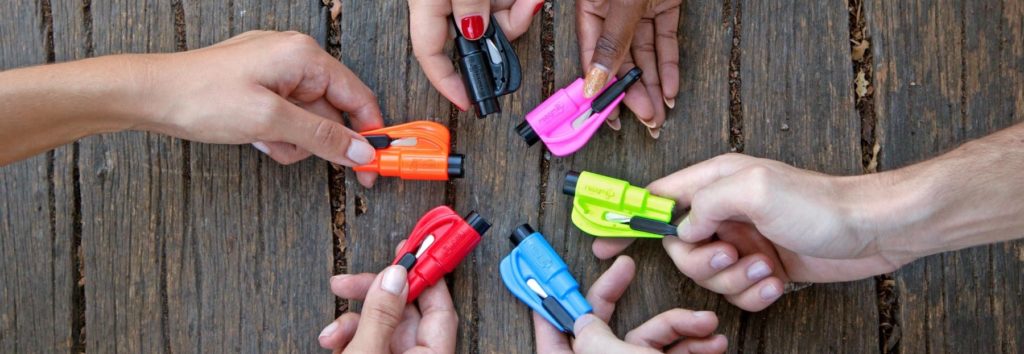Trapped inside your car? Learn lifesaving tips!
In USA and around the world, governments and associations are fighting for road safety, focusing their efforts on prevention, to avoid accidents.
The risk of being stuck in a vehicle is limited. However, no one is ever safe from unexpected accidents.
. 1 because today’s cars incorporate more electronic equipment which may, in some cases, turn into a scary trap from electric windows, central locking, and automatic locking …
Also as a result of a road accident, anyone can find themselves locked in the car or faced with imminent danger (fire, explosion, car rollover or trapped in a flooded area)
THINK YOU ARE EQUIPPED: prevention is key. Professional experts recommend to carry a safety tool. For example, the ResQMe tool that combines two functions, cutting seat belts and breaking the glass side and rear windows. Always leave it in a place accessible and always make sure you have a first aid survival kit when every second counts.
THE STEPS THAT SAVE LIVES
I. Your vehicle is in a flood zone:
• Never attempt to cross a flooded road. Note that 20 inches of water can make you lose control of your vehicle and be carried away in the water!
• Turn around and alert other vehicles. Call 911 and tell them the place of the flooded area.
• Stay away from this area and head to higher ground.
II . If you’re already facing the flooded area with no way to turn around:
• Take a deep breath
• Do not panic
• Survey the current
• Unbuckle your seatbelt
• Open or break your window
• We recommend that you get on the roof of your car or swim ashore to avoid risk of hypothermia * .
III . Your vehicle fell into a body of water: You have one minute to get out!
During the flotation stage it is essential to quickly exit the vehicle.
• Take a deep breath
• Do not panic
• Do not use your mobile phone.
• BELT: detach or euse the resqme® to cut if jammed.
• SIDE WINDOW: open it or, if it does not work, break it with resqme® while protecting your eyes.
• CHILDREN: detach their seatbelts or cut off their belts if jammed and remove them from largest to smallest.
• OUT – RIDE on the roof of your car or swim to shore. Avoid hypothermia *.
IV . Your vehicle is smoking and/or fire is starting
• Gently pull off the road and park on the side as quickly as possible.
• Turn the ignition off.
• Put on your safety vest, remove and move away and all your passengers.
• Secure the area and try to warn other drivers.
• In case of fire do not attempt to extinguish the fire yourself, or open the hood of your vehicle.
• Call 911
V. Other risks and tips to follow
NEVER LEAVE A CHILD unaccompanied in a vehicle unattended *. If you see a child stuck in a vehicle in high heat call 911 and find a security guard on the premises.
Other tips to follow :The principal operation of the remote control key in some high end model cars is that once activated, the system disables the internal ability to open the doors. Developed to transform the cabin into a safe place for people still inside. The French car remotes offer these particular options. If your car is equipped with this system, there is a plan B to get out.
Plan B:
Anticipating somewhat and keeping your cool, leaving the vehicle in seconds can be easy and accessible to all.
Here are tips to know and communicate with your passengers.
NO HORN BUT THE HEADLIGHTS AND WARNING LIGHTS ALWAYS WORK ONCE THEY ARE SWITCHED ON.
* Hyperthermia is local or systemic elevation of body temperature above the normal value (98 to 100° F), due to the accumulation of exogenous heat. In humans, there is a risk of death beyond 106 ° F (irreversible brain damage). The temperature rise in a passenger vehicle depends not only on the outside temperature, but also the degree of sunshine.
Indeed, if the outside temperature is 80° F, after 10 minutes, the temperature inside a vehicle will average after:
o 10 minutes at 98 °F over
o more than 20 minutes at 108 ° F
o more than 30 minutes at 114 ° F
o more than 40 minutes at 118 ° F
o more than 50 minutes at 120 ° F
o more than 60 minutes at 123 ° F
“Opening” a little window will hardly change the temperature. The color of the vehicle and the body color may also be one of the risk factors.
Hypothermia * In humans, the normal inner temperature is 98.6°F ; There is talk of hypothermia when the core temperature is below 95° F : Below 82°F there is a risk of cardiac arrest.
Without thermal protection, you may lose body heat 25 times faster in water than in air ; and this loss can even be multiplied by 10 if you swim or if the water is flowing.
• The best flotation device to combat the effects of cold water immersion is one that offers maximum thermal protection, such as a jacket and overalls or a floating survival suit.
• Bring legs against the body and stand with arms (fetal position), which will help retain body heat.
• Put as much as possible against each other to once again retain maximum body heat.
Reminder:
• 98.6 to 95°F : normal hypothermia with some chills
• from 95 to 90°F Moderate hypothermia must try to combat.
• from 90 to 82° F : Limited hypothermia, stop chills and risks loss of consciousness
• 90 to 75° F: severe hypothermia , reduced or no vital signs
• below 75 ° F :major hypothermia, most likely cardiac arrest .
* The sources are experts in security, various scientific publications such as Operation Lifeline University of Manitoba ( Canada) , Department of Geosciences at the University of San Francisco (United States ) and Services weather and fire.
The above information may be used by an application in writing and not by consent of the owner.
© ResQMe , Inc. – All rights reserved
Remember : You can ask for help in an emergency in the 27 Member States of the European Union with the 112 emergency number.
These Member States are: Germany , Austria , Belgium , Bulgaria, Cyprus, Denmark , Spain , Estonia, Finland, France , Greece, Hungary, Ireland, Italy, Latvia , Lithuania , Luxembourg , Malta, the Netherlands , Poland, Portugal, Czech Republic , Romania, the United Kingdom , Slovakia , Slovenia and Sweden.
In the following countries, the emergency number 112 is also active : Israel, Norway , Russia, Turkey and Switzerland.
United States – Canada: 911
Australia: 000
China – Japan: 119

